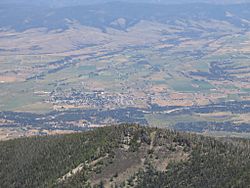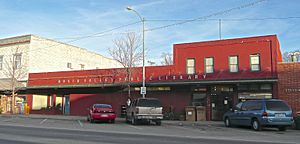Stevensville, Montana facts for kids
Quick facts for kids
Stevensville, Montana
|
|
|---|---|

Stevensville and the Bitterroot River
seen from Saint Mary's Peak (2005) |
|

Location of Stevensville, Montana
|
|
| Country | United States |
| State | Montana |
| County | Ravalli |
| Government | |
| • Type | Mayor-Council |
| Area | |
| • Total | 1.31 sq mi (3.40 km2) |
| • Land | 1.29 sq mi (3.35 km2) |
| • Water | 0.02 sq mi (0.05 km2) |
| Elevation | 3,323 ft (1,013 m) |
| Population
(2020)
|
|
| • Total | 2,002 |
| • Density | 1,545.95/sq mi (596.90/km2) |
| Time zone | UTC-7 (Mountain (MST)) |
| • Summer (DST) | UTC-6 (MDT) |
| ZIP code |
59870
|
| Area code(s) | 406 |
| FIPS code | 30-71200 |
| GNIS feature ID | 2413335 |
Stevensville (in Salish: ɫq̓éɫmlš) is a town in Ravalli County, Montana, United States. In 2020, about 2,002 people lived there.
Stevensville is known as the first lasting settlement by non-native people in Montana. It was settled by Jesuit missionaries. They came in 1841 because the Bitterroot Salish tribe asked them to. This happened 48 years before Montana became a state.
Contents
History of Stevensville
The Bitterroot Valley was the original home of the Bitterroot Salish people. Between 1812 and 1821, the Salish learned about Christianity. They heard about it from Iroquois fur traders.
Early Requests for Missionaries
In 1831, four young Salish men traveled to St. Louis, Missouri. They went to ask for "Black Robes," which was their name for missionaries. They met with William Clark of the Lewis and Clark Expedition. He was in charge of their home territory. Sadly, two of the Salish men died during this difficult trip. The other two met with Bishop Joseph Rosati. He promised that missionaries would be sent when possible.
The Bitterroot Salish sent more requests in 1835 and 1837. But no missionaries came. Finally, in 1839, some Iroquois and Salish people met Father Pierre-Jean De Smet. This meeting happened in Council Bluffs. Father DeSmet promised to send a missionary the next year.
Founding St. Mary's Mission
In 1841, Father DeSmet led a group of Jesuits to the Bitterroot Valley. They started St. Mary's Mission. This became the first permanent settlement by non-native people in what is now Montana. They quickly built a chapel and log cabins.
The settlement was home to many "firsts" in Montana. These included the first irrigation, farming, ranching, and cattle branding. In 1845, Father Ravalli, a Jesuit priest and doctor, arrived. He built the first pharmacy there.
Changes and New Names
In 1850, Major John Owen came to the valley. He set up a camp north of St. Mary's. When Blackfeet raids forced the mission to close, Owen bought it. He turned it into a trading post called Fort Owen. Later, the Jesuits returned and built a new church. Both St. Mary's Mission and Fort Owen still have buildings standing today. They show Stevensville's long history.
The settlement's name changed from St. Mary's to Stevensville in 1864. This was to honor the territorial governor, Isaac Stevens. In 1879, G. A. Kellogg planned out the town. In 1891, the Bitterroot Salish who were still in the valley had to move. They were forced to go to the Flathead Indian Reservation.
In 1893, Ravalli County was created. Stevensville became the county seat, which is like the main government town. But in 1898, Stevensville lost an election to Hamilton. So, Hamilton became the new county seat. More than forty buildings in Stevensville are listed as historic places.
Geography and Nature
Stevensville covers about 1.00 square mile (2.59 square kilometers). Most of this area is land, with a small part being water.
The town is surrounded by the Bitterroot and Sapphire mountains. This gives it beautiful views and chances for outdoor fun. You can also see wildlife here. The Bitterroot Mountain Range is west of Stevensville. It is the longest single mountain range in the Rocky Mountains. The Bitterroot River flows along the town's eastern side.
Climate in Stevensville
Stevensville has a climate with big changes in temperature during the year. Summers are warm to hot, but usually not humid. Winters are cold, and sometimes very cold. This type of weather is called a humid continental climate.
| Climate data for Stevensville, Montana (1991–2020 normals, extremes 1911–present) | |||||||||||||
|---|---|---|---|---|---|---|---|---|---|---|---|---|---|
| Month | Jan | Feb | Mar | Apr | May | Jun | Jul | Aug | Sep | Oct | Nov | Dec | Year |
| Record high °F (°C) | 63 (17) |
70 (21) |
80 (27) |
88 (31) |
98 (37) |
104 (40) |
107 (42) |
104 (40) |
98 (37) |
87 (31) |
74 (23) |
65 (18) |
107 (42) |
| Mean daily maximum °F (°C) | 34.6 (1.4) |
38.3 (3.5) |
49.6 (9.8) |
58.0 (14.4) |
67.5 (19.7) |
74.8 (23.8) |
85.3 (29.6) |
83.9 (28.8) |
73.6 (23.1) |
58.0 (14.4) |
42.5 (5.8) |
33.1 (0.6) |
58.3 (14.6) |
| Daily mean °F (°C) | 26.8 (−2.9) |
29.8 (−1.2) |
38.0 (3.3) |
45.0 (7.2) |
53.2 (11.8) |
60.1 (15.6) |
67.1 (19.5) |
65.6 (18.7) |
57.0 (13.9) |
45.0 (7.2) |
33.5 (0.8) |
26.0 (−3.3) |
45.6 (7.6) |
| Mean daily minimum °F (°C) | 18.9 (−7.3) |
21.2 (−6.0) |
26.3 (−3.2) |
32.0 (0.0) |
38.9 (3.8) |
45.4 (7.4) |
49.0 (9.4) |
47.2 (8.4) |
40.4 (4.7) |
32.1 (0.1) |
24.5 (−4.2) |
18.9 (−7.3) |
32.9 (0.5) |
| Record low °F (°C) | −36 (−38) |
−37 (−38) |
−19 (−28) |
2 (−17) |
15 (−9) |
27 (−3) |
30 (−1) |
27 (−3) |
7 (−14) |
−3 (−19) |
−28 (−33) |
−36 (−38) |
−37 (−38) |
| Average precipitation inches (mm) | 1.00 (25) |
0.92 (23) |
0.77 (20) |
0.93 (24) |
1.45 (37) |
1.59 (40) |
0.83 (21) |
0.81 (21) |
0.84 (21) |
1.04 (26) |
1.15 (29) |
1.12 (28) |
12.45 (316) |
| Average snowfall inches (cm) | 4.0 (10) |
3.0 (7.6) |
1.5 (3.8) |
0.1 (0.25) |
0.0 (0.0) |
0.0 (0.0) |
0.0 (0.0) |
0.0 (0.0) |
0.0 (0.0) |
0.1 (0.25) |
1.6 (4.1) |
6.8 (17) |
17.1 (43) |
| Average precipitation days (≥ 0.01 in) | 9.4 | 7.6 | 9.5 | 8.7 | 10.0 | 10.1 | 5.5 | 6.0 | 6.5 | 8.5 | 9.0 | 9.3 | 100.1 |
| Average snowy days (≥ 0.1 in) | 3.2 | 1.7 | 0.9 | 0.2 | 0.0 | 0.0 | 0.0 | 0.0 | 0.0 | 0.2 | 0.9 | 2.3 | 9.4 |
| Source: NOAA | |||||||||||||
People and Population
| Historical population | |||
|---|---|---|---|
| Census | Pop. | %± | |
| 1880 | 47 | — | |
| 1900 | 346 | — | |
| 1910 | 796 | 130.1% | |
| 1920 | 744 | −6.5% | |
| 1930 | 692 | −7.0% | |
| 1940 | 703 | 1.6% | |
| 1950 | 772 | 9.8% | |
| 1960 | 784 | 1.6% | |
| 1970 | 829 | 5.7% | |
| 1980 | 1,207 | 45.6% | |
| 1990 | 1,221 | 1.2% | |
| 2000 | 1,553 | 27.2% | |
| 2010 | 1,809 | 16.5% | |
| 2020 | 2,002 | 10.7% | |
| U.S. Decennial Census | |||
Population in 2010
In 2010, there were 1,809 people living in Stevensville. There were 836 households, and 455 of these were families. Most of the people (96.0%) were White. About 1.0% were Native American. A small number were from other backgrounds.
About 24.9% of households had children under 18. About 40.8% were married couples. The average household had 2.11 people. The average family had 2.87 people. The average age in town was 42.3 years old.
Education in Stevensville
Stevensville Public Schools teaches students from kindergarten through 12th grade. Stevensville High School had 383 students in the 2021–2022 school year. Their sports teams are called the Yellowjackets.
The North Valley Public Library is also located in Stevensville.
Local Media
The Bitterroot Star is a newspaper published every week. It is owned by Mullen Newspaper Company.
The FM radio station KKVU is also licensed in Stevensville.
Transportation and Roads
You can get to Stevensville from U.S. Route 93. You take Montana Highway 269. Montana Highway 203 leaves town to the northeast.
The Stevensville Municipal Airport is a public airport owned by the town. It is about 2 miles (3.2 km) northeast of town. The closest airport for commercial flights is Missoula Montana Airport. It is about 32 miles (51 km) north.
Famous People from Stevensville
- Janine Benyus, an author
- Tyler Bradt, a whitewater kayaker
- Edward Catich, an author born in the town
- Huey Lewis, lead singer of Huey Lewis and the News
- Marion Marshall, an actress
- Washington J. McCormick, a U.S. Representative who retired here
- George McGovern, a politician who owned a bookstore and summer home nearby
- Lee Metcalf, a U.S. congressman and senator from Montana
- Kathleen Meyer, an author
- Anthony Ravalli, a Jesuit pioneer
See also
 In Spanish: Stevensville (Montana) para niños
In Spanish: Stevensville (Montana) para niños


